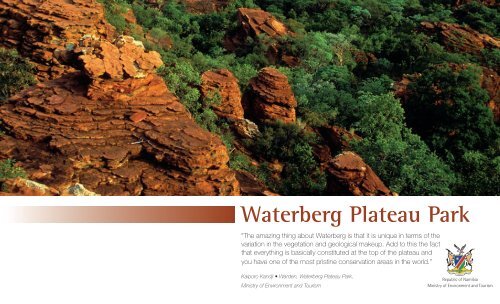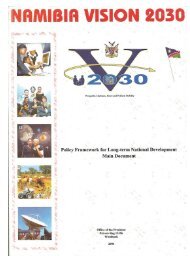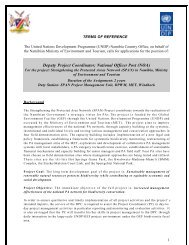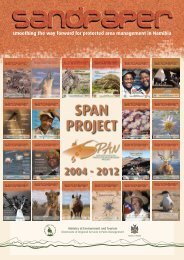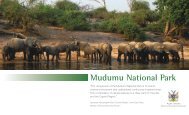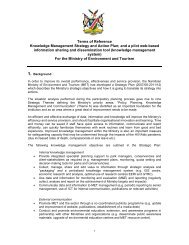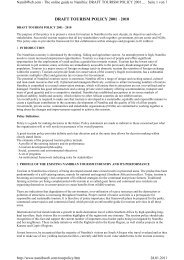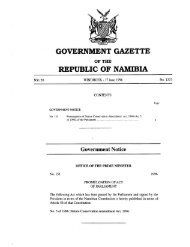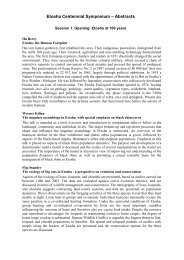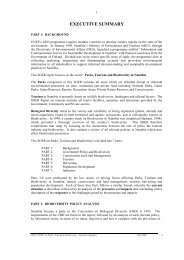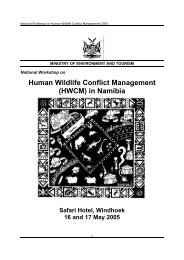Waterberg Plateau Park - Ministry of Environment and Tourism
Waterberg Plateau Park - Ministry of Environment and Tourism
Waterberg Plateau Park - Ministry of Environment and Tourism
You also want an ePaper? Increase the reach of your titles
YUMPU automatically turns print PDFs into web optimized ePapers that Google loves.
<strong>Waterberg</strong> <strong>Plateau</strong> <strong>Park</strong><br />
“The amazing thing about <strong>Waterberg</strong> is that it is unique in terms <strong>of</strong> the<br />
variation in the vegetation <strong>and</strong> geological makeup. Add to this the fact<br />
that everything is basically constituted at the top <strong>of</strong> the plateau <strong>and</strong><br />
you have one <strong>of</strong> the most pristine conservation areas in the world.”<br />
Kaiporo K<strong>and</strong>ji • Warden, <strong>Waterberg</strong> <strong>Plateau</strong> <strong>Park</strong>,<br />
<strong>Ministry</strong> <strong>of</strong> <strong>Environment</strong> <strong>and</strong> <strong>Tourism</strong><br />
Republic <strong>of</strong> Namibia<br />
<strong>Ministry</strong> <strong>of</strong> <strong>Environment</strong> <strong>and</strong> <strong>Tourism</strong>
Discover the <strong>Waterberg</strong> <strong>Plateau</strong> <strong>Park</strong><br />
Over 150 million years ago, dinosaurs roamed the plateau at <strong>Waterberg</strong>.<br />
Now you can too, <strong>and</strong> discover the amazing variety <strong>of</strong><br />
plant <strong>and</strong> animal life that thrives here today. Rising some 200<br />
metres above the surrounding African savannah, the <strong>Waterberg</strong><br />
<strong>Plateau</strong> with its brilliant brick-red s<strong>and</strong>stone formations <strong>and</strong><br />
lush green vegetation is a wonderous place to explore. Take on<br />
the challenge <strong>of</strong> a three-day hike, accompanied by a park ranger,<br />
to the <strong>Waterberg</strong>’s summit, or the thrill <strong>of</strong> setting out on your<br />
own 42-km self-guided trail. Catch a glimpse <strong>of</strong> an illusive leopard<br />
or patiently stalk a herd <strong>of</strong> sable through the dense bush.<br />
Visit the Vulture Restaurant, a conservation effort designed to<br />
attract hundreds <strong>of</strong> vultures, including Cape vultures, where they<br />
feast. Guided game drives on the plateau, plus time spent in a<br />
hide lying in wait for rare species to approach a waterhole, give<br />
you the chance to learn more about one <strong>of</strong> the most unique<br />
conservation areas in the world.<br />
A natural fortress for conservation<br />
The <strong>Waterberg</strong> <strong>Plateau</strong> <strong>Park</strong> is not only an isl<strong>and</strong> <strong>of</strong> vibrant colour<br />
<strong>and</strong> biodiversity; it presents a natural opportunity for conservation.<br />
The park was initially proposed to protect el<strong>and</strong>, Africa’s<br />
largest antelope, but, recognising the natural physical defences<br />
<strong>of</strong> the plateau against human <strong>and</strong> livestock encroachment, conservationists<br />
soon introduced other endangered animals in an<br />
effort to establish protected breeding populations. Black <strong>and</strong><br />
white rhinoceros, Cape buffalo, <strong>and</strong> tsessebe, sable <strong>and</strong> roan antelope<br />
have all been reintroduced onto the <strong>Waterberg</strong> <strong>Plateau</strong>.<br />
These species are on the increase <strong>and</strong> surplus populations are released<br />
regularly in other protected environments. State-<strong>of</strong>-theart<br />
game bomas have been constructed, in which captured animals<br />
are held prior to auction <strong>and</strong> relocation. The Game Products<br />
Trust Fund (GPTF) ploughs pr<strong>of</strong>its from the auctions back into<br />
conservation. Poaching has been eliminated, <strong>and</strong> the <strong>Waterberg</strong><br />
<strong>Plateau</strong> <strong>Park</strong> st<strong>and</strong>s as a natural fortress for conservation.
A world unto itself<br />
It is hard to imagine Namibia submerged in water or smothered<br />
in ice but both have happened <strong>and</strong> the <strong>Waterberg</strong> is the result.<br />
Made <strong>of</strong> harder material than the surrounding areas, the plateau<br />
has weathered the crushing forces <strong>of</strong> climate change <strong>and</strong> the<br />
resulting erosion. Today, thanks to its daunting cliffs, the <strong>Waterberg</strong><br />
<strong>Plateau</strong> <strong>Park</strong> remains a highly biodiverse environment<br />
that is a world unto itself. More than 35 years after it was originally<br />
proclaimed to protect el<strong>and</strong>, the species is now thriving<br />
<strong>and</strong> herds <strong>of</strong> up to a hundred strong <strong>of</strong>ten congregate on the<br />
plateau. Some twenty-five other species <strong>of</strong> large mammals occur<br />
here, including giraffe, kudu, impala, <strong>and</strong> warthog. Predators<br />
are equally at home on the <strong>Waterberg</strong>. Leopards prowl along the<br />
cliffs, while cheetah, caracal <strong>and</strong> black-backed <strong>and</strong> side-striped<br />
jackals are more likely to be seen on top <strong>of</strong> the plateau or in<br />
the savannah below. Occasionally wild dogs <strong>and</strong> lion visit the<br />
plateau from the east.<br />
A birders’ paradise<br />
<strong>Waterberg</strong> is a birding delight! Over 200 species have been recorded<br />
in the park. In addition to hosting 33 species <strong>of</strong> birds<br />
<strong>of</strong> prey, including black eagles, the <strong>Waterberg</strong> has the highest<br />
density <strong>of</strong> peregrine falcons in Africa. It is also home to the last<br />
remaining population <strong>of</strong> Cape vultures in Namibia. These are<br />
the rarest birds in the country with perhaps only ten remaining.<br />
Poisoned bait set by farmers to kill predators is the principal<br />
cause <strong>of</strong> their decline. A ‘vulture restaurant’ has been established<br />
where carcasses attract hundreds <strong>of</strong> vultures, including the Cape<br />
vultures. Feedings are open to the public <strong>and</strong> <strong>of</strong>fer excellent<br />
photo opportunities. Of the eleven endemic bird species in the<br />
country, seven occur here. Look out for the rockrunner (Achaetops<br />
pycnopygius), Hartlaub’s francolin (Francolinus hartlaubi),<br />
Rüppell’s parrot (Roicephalus rueppelli), Bradfield’s swift (Apus<br />
bradfield), Monteiro’s hornbill (Tockus monteiri), short-toed rock<br />
thrush (Monticola brevipes), <strong>and</strong> Carp’s tit (Parus carpi).
Man’s mark on the <strong>Waterberg</strong><br />
The first human occupants at the <strong>Waterberg</strong> were the San,<br />
whose engravings can still be seen on the rocks at the Okarakuvisa<br />
waterhole. The images may well be tens <strong>of</strong> thous<strong>and</strong>s <strong>of</strong><br />
years old. A community <strong>of</strong> San still lived at this site until the<br />
end <strong>of</strong> the 1960s. While the <strong>Waterberg</strong> has witnessed various<br />
conflicts, the most dramatic military encounter occurred in 1904<br />
when German colonial forces fought the Herero people who had<br />
staged an uprising led by Chief Samuel Maharero. The Hereros<br />
subsequently fled into the waterless Omaheke plains with their<br />
treasured cattle <strong>and</strong> many thous<strong>and</strong>s perished. A small, rather<br />
mysterious, cemetery near the park entrance holds the remains<br />
<strong>of</strong> some <strong>of</strong> the dead. In 1907 the <strong>Waterberg</strong> was proclaimed<br />
Game Reserve No 4 by German authorities. It was de-proclaimed<br />
in 1928. Fruit farms were established at its base, supplying the<br />
whole country with citrus fruit. These are now gone. The park<br />
was established in 1972 <strong>and</strong> is still exp<strong>and</strong>ing.<br />
Trails <strong>and</strong> so much more<br />
Trails are very much part <strong>of</strong> the <strong>Waterberg</strong> experience, <strong>and</strong> nine<br />
have been laid out along the base <strong>of</strong> the plateau in the resort. In<br />
addition there are three day hikes accompanied by a park ranger<br />
or warden on the summit <strong>and</strong> a strictly controlled 42-km selfguided<br />
trail. Hikers follow natural routes, along cleared trails <strong>and</strong><br />
through dry river courses. Hikers are expected to be self-sufficient,<br />
although there are shelters with water. Fires are not permitted.<br />
<strong>Waterberg</strong> <strong>Plateau</strong> <strong>Park</strong> fact sheets provide more details<br />
on the hiking trails. Bookings for the longer trails are made with<br />
the Namibia Wildlife Resorts <strong>of</strong>fice (www.nwr.com.na).<br />
Please note: The summit is <strong>of</strong>f-limits to unauthorised vehicles.<br />
There are daily guided game drives (approximately four hours)<br />
that also include visits to state-<strong>of</strong>-the-art hides on the plateau<br />
that <strong>of</strong>fer excellent views <strong>of</strong> waterhole life. Participants are advised<br />
to bring warm clothing.
<strong>Environment</strong>al Care Code<br />
C22<br />
Please adhere to the following:<br />
• Do not feed the animals.<br />
• Keep your belongings in a safe place away<br />
from inquisitive baboons.<br />
• Do not litter.<br />
• Please follow the rules <strong>and</strong> regulations listed on your<br />
park permit.<br />
Have fun!<br />
B1<br />
The MET’s Okatjikona<br />
<strong>Environment</strong>al Education Centre<br />
Situated on the fringe <strong>of</strong> the park, this is one <strong>of</strong><br />
Namibia’s leading environmental education centres.<br />
The Centre hosts school, university <strong>and</strong> institutional<br />
groups <strong>and</strong> organises learning tours <strong>of</strong> the<br />
<strong>Waterberg</strong> in conjunction with park staff. Fees are<br />
small. For bookings contact: The Warden (Okatjikona<br />
<strong>Environment</strong>al Education Centre), Private Bag<br />
2506, Otjiwarongo, Namibia. Tel: 067 30 6320, Fax:<br />
067 30 7922<br />
Facilities:<br />
Bungalows, swimming pool, restaurant <strong>and</strong> camping<br />
are available at the <strong>Waterberg</strong> Camp. For bookings,<br />
contact Namibia Wildlife Resorts (www.nwr.<br />
com.na).<br />
How to get there:<br />
Take the B1, the main north/south tarred road, <strong>and</strong><br />
turn east on the C22 to the <strong>Waterberg</strong> <strong>Plateau</strong> <strong>Park</strong>.<br />
Take the D2512 for 33 km up to the park’s <strong>of</strong>fice at<br />
Onjoka. The park is located 60 km east <strong>of</strong> Otjiwarongo<br />
<strong>and</strong> 300 km north-east <strong>of</strong> Windhoek.<br />
Fact File:<br />
Proclamation date: 1972<br />
Size: 405.39 km 2<br />
Altitude: 1 650–1 700 m above sea level<br />
www.met.gov.na<br />
Sponsored by:


